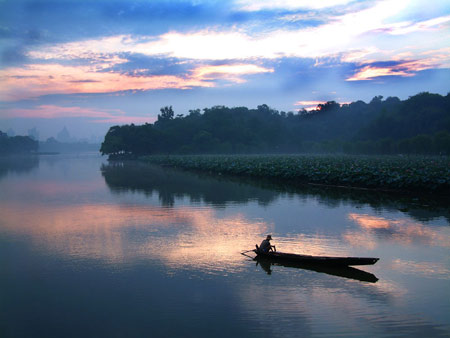| Tools: Save | Print | E-mail | Most Read |
| Living la Dolce Vita in Hangzhou |
| Adjust font size: |
A popular Chinese saying that has survived the centuries expresses the ideal life thus "to be born in The reason why life in
For foreign travelers, the capital of The urban area of Hangzhou encompasses 3,068 square kilometers and has a population of more than 3.7 million, while the greater Hangzhou region covers over 16,500 square kilometers, including eight administrative districts and five counties. The end of the Tianmu Mountain Range makes up the hilly areas of the city. The major waterways in the area are the History of the city The history of civilization in Chinese historians regard the Liangzhu Culture as the first peak of the city's development.
It existed roughly 4,000 - 5,300 years ago, and archaeological discoveries of material proof, like carbonized rice seeds and jade carvings, point at 5,000 years of civilization in the area. King Qian, the founder of the Therefore, thoughts of warless worlds and peace-seeking and people-centric communities established the foundation of Politically, the kingdom was the only one of its time not to be affected by the civil war sweeping across the country. This enabled its people to develop rapidly and cultivate their considerable skills in silk weaving, tea production, papermaking, brewing, and porcelain making. Consequently, the kingdom marked the second The most remarkable era of the city's history was during the Southern Song Dynasty (AD 1127 - 1279), when the capital was moved from The urban population rocketed to more than 1 million after numerous migrants flocked there from the Central Plains. What's more, the city's fame drew many foreigners from more than 40 countries around the world to live in the city under various exchange programs. Taoism and Buddhism reached their peaks during this period, when a great number of temples sprang up citywide. Many of them can still be seen today. The modern city The downfall of the Southern Song Dynasty was mainly caused by the dispirited kings whose minds and thoughts were intent upon nothing but bodily pleasures. This has resulted in the impression among the Chinese over the centuries that The The leisure industry which combines travel, sports, entertainment and art has brought considerable benefits to the city, and sparked the flowering of the local service industry. In an effort to improve the city's reputation abroad, the In addition, the revival of the West Lake Expo has played a crucial role in not only promoting tourism in The very first West Lake Expo of 1929 is regarded as the biggest exhibition the country has seen in modern times, showcasing The newly resumed annual event has more than 100 promotional programs in the fields of leisure and travel, conference and training, exhibitions, sports and literary activities. To a large extent, the expo has been a major driving force for the city's double-digit gross domestic product growth. The World Leisure Expo 2006, one of the most important international events in China in the new millennium, no doubt added luster to the Oriental Capital of Leisure, with more than 20.4 million tourists from all over the world attending within a six-month period. Meanwhile, The new project claims to improve people's quality of life in the next five years in terms of economy, culture, environment, politics and society, and hopes to make the city one of the most desirable places to live in In February, Discovering In order to make it easier for foreign tourists to discover the charms of Free copies are available in three-star hotels or above and at tourist information centers, as well as various travel centers, airports, railway stations and coach stations in Apart from this, there are two free periodicals for foreign visitors and residents Taste Hangzhou (a Japanese bimonthly magazine) and Hangzhou Weekly (an English weekly newspaper), offering a window into the modern life and cultural developments of the city. It has introduced more than 100 long or short routes for single travelers or groups. (
|
| Tools: Save | Print | E-mail | Most Read |
 |
| Related Stories |
|
Product Directory China Search |
Country Search Hot Buys |

